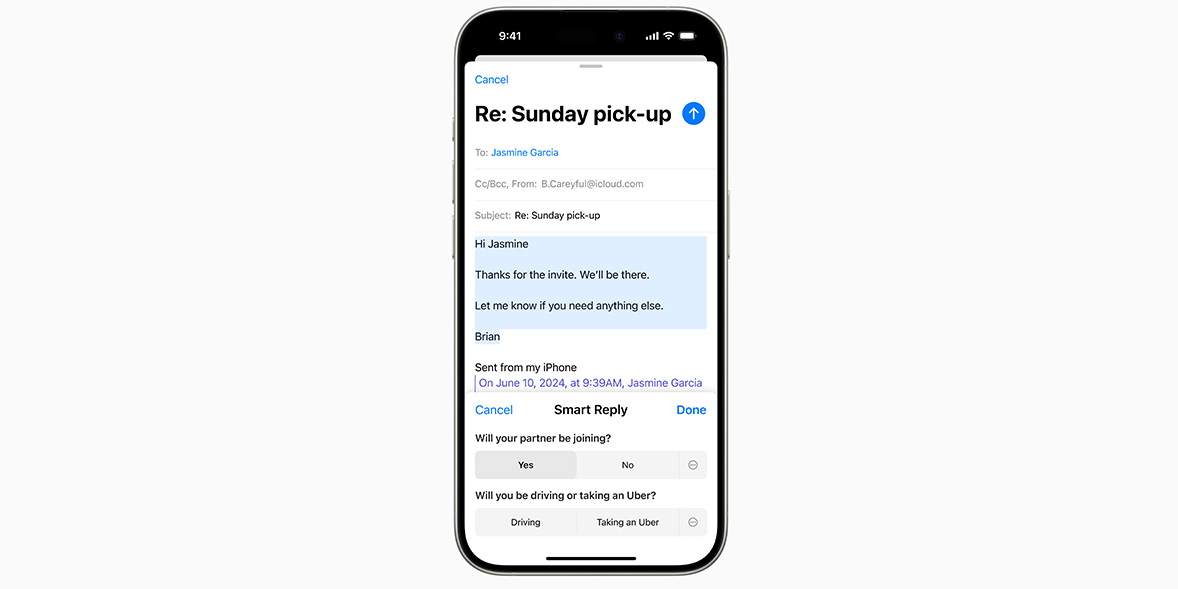By clicking a retailer link you consent to third-party cookies that track your onward journey. This enables W? to receive an affiliate commission if you make a purchase, which supports our mission to be the UK's consumer champion.
Apple vs Google vs Samsung: which phone has the best AI?

Artificial intelligence (AI) is a major feature in 2025’s new smartphones, with most brands promising tools to make your life easier. But, how well do these features work in practice?
To help you understand which AI tools are genuinely useful, and which brand does it best, we’ve put these newfangled features to the test in our labs in an in-depth investigation.
The outcome is based on rigorous, side-by-side analysis of three of this year’s top phones: the Apple iPhone 16 Pro Max, Google Pixel 9 Pro XL and Samsung Galaxy S25 Ultra.
Read on for all the key lab-tested results explaining which phone has the best AI for your needs.
Our guide to the best mobile phones for 2025 reveals the models that aced our lab tests.
Summarising and rewriting text and messages

AI tools promise to save you time by summarising a range of content you might receive through a phone, from notifications to emails, and can also tweak your writing style for different purposes. All three phone AIs include a range of tools.
One key AI smartphone function is the ability to summarise and prioritise notifications, which creates short overviews of your alerts on a lock screen. This feature is currently an iOS exclusive, and in our testing of the iPhone 16 Pro Max, we found it performed pretty well. The summaries were correct and the prioritisation worked as intended – reducing interruptions, even when dealing with ambiguous idioms such as ‘bite the bullet’ or ‘break a leg’.
For those interested in summarising longer content like articles and emails, all three phones provided good results. However, we found the user experience to be more convenient on the iPhone and Samsung phones, which have these features integrated directly into their native apps – Safari and Mail, Samsung Internet and Samsung Email, respectively. The Google Pixel required extra effort, as you had to copy text or links into the separate Gemini app. Extra kudos go to Samsung for offering the option of a ‘standard’ or more ‘detailed’ summary.
AI can also offer help with your writing, taking your drafted text and rewriting it in a different style. The iPhone’s Writing Tools performed very well here, easily shifting the tone of messages and allowing for custom instructions, such as asking it to rewrite a part invitation in the style of a social media post. The Galaxy S25 Ultra did a good job with its various presets, too. Google’s flagship produced high-quality results, but it added that extra step by requiring users to head to Gemini.
Winner: Apple iPhone 16 Pro Max
The iPhone wins this section. Its exclusive notification summaries were a clear plus, and its writing tools were very helpful. Samsung was a close second with its own great tools, while Google’s AI also worked well, but was less convenient to use, so it placed just behind.
Photo, video, and image tools

Modern phone AI is improving how we manage and edit our photos and videos. These tools can help you find a specific memory in a library of thousands, automatically clean up your pictures by removing unwanted people or objects, and even improve the audio in your videos. They also offer creative features, allowing you to generate entirely new images and wallpapers with a simple text command.
The latest round of flagships offers the ability to search your photo gallery using natural language voice commands. Think, searching ‘a sunset at the beach’. None of the phone tests let you start this process directly from their main voice assistants – instead, requiring you to head to their gallery apps. But once there, the feature is tremendously powerful.
The iPhone 16 Pro Max was excellent at this, successfully finding photos based on objects, description text (such as the phrase ‘relaxing on a boat’), text within a picture and even landmarks when the photo had no location data attached. The Pixel performed well, too, but was often less accurate, producing a wider range of results. For Samsung, the gallery isn’t as versatile, with it not being possible to find text within images or landmarks in our testing.
Taking this a step further is the AI feature, which allows you to search for a specific moment within a video. It’s another iPhone-exclusive tool at the time of our test. It worked very well, successfully identifying a fish in a video of an aquarium and highlighting when it appeared in the video.
For video creators, the Audio Mix/Audio Eraser tool smartly reduces background noise to make speech clearer. This was a close-run thing in our testing, with all three phones producing good and comparable results. They all successfully reduced constant background noise and harsh, sporadic sounds.
Another AI-powered photo feature is the 'magic editor'. This lets you remove unwanted objects from images. In a comparison across 18 different test photos, the Samsung Galaxy S25 Ultra performed best. Its edits showed the fewest distracting flaws in the final image, leaving it the cleanest. The iPhone and Pixel results were comparable, but both showed more noticeable imperfections than the Samsung. Its tool was also the most versatile, allowing users to move, resize and even generate new objects from a sketch.
Finally, AI can be used to generate images and wallpapers from a text description. All three phones offer plenty of options. The Galaxy S25 Ultra was the most flexible, with the ability to generate images from text, photos and even user-drawn sketches. The Google Pixel offered a wide range of 18 preset styles to helpfully guide the result. Apple’s flagship was the least impressive, but this is likely a consequence of added privacy controls, which limit this feature to running offline while its rivals require an internet connection. This means the iPhone does all of the work on the device. In contrast, Android uses a remote server to provide the images.
Winner: Samsung Galaxy S25 Ultra
Samsung takes the lead here, but it's a very close race. Its tools for editing photos and creating new images gave the best results. The iPhone fought back, proving much better at finding photos and videos. Google’s tools were also good, but didn’t stand out against the competition.
Running out of storage on your phone? Take a look at our guide on how to free space on your smartphone to quickly make some extra room.
Search and chat shortcuts

AI shortcuts aim to speed up common tasks on your phone. This can range from suggesting one-tap replies to your messages to visual search tools that let you find information about anything on your screen just by circling it. Some phones even offer features to automatically transcribe and summarise your recorded calls, saving you from having to take notes.
Smart reply provides AI-suggested, one-tap replies to messages and emails. The iPhone and Google Pixel both offer this feature integrated into the keyboard. The suggestions are very short, but do the job in providing a quick and appropriate response. This feature wasn't found as a system-level feature on the Samsung device during testing. There are also some more advanced chat and note-assist tools that help you auto-format your notes or translate chats.
The iPhone’s Writing Tools were the best here, able to swiftly transform a mess of notes (such as a rough mindmap for a trip to Italy) into key points and tables. Samsung’s Note Assist did a strong job of creating clear meeting notes, but it failed when using its 'Headers and bullets' functions, incorrectly bulleting every sentence of the notes outside of the headings. Again, Google required the use of the Gemini app to complete this task.
Samsung and Apple offer the ability to record a phone call, and have the AI transcribe and summarise the conversation. However, our lab was unable to test this on the Samsung as it wasn’t available to our testers, being unavailable in the UK and EU. Apple has chosen to include the AI feature, however. On the iPhone, it worked well, providing an accurate transcription and a useful summary from a 15-minute call.
Visual search tools such as Apple Visual Intelligence and Circle to Search (Android) let you get information about an object just by pointing your camera at it. In our testing, all three phones performed excellently and received comparable ratings. Information was useful, and typically correct when used for identifying and providing information on a variety of objects, from a guitarist's finger trainer to a longboard.
Winner: Draw – Apple & Samsung
This one is too close to call. The iPhone has highly effective tools for formatting and organising notes. However, Samsung’s exclusive and functional call recording feature gives it a boost to keep it in the running. Google lags behind due to its less convenient, app-based approach for these tasks.
Voice recognition

The AI behind voice assistants is being developed to better understand natural, conversational language. The goal is for you to be able to talk to your phone less like a robot and more like a human assistant, allowing for follow-up questions and more complex commands. We tested how well each phone's assistant handles these more fluid interactions.
We couldn’t have a complete AI test without returning to the feature that started it all – AI voice assistants. When it comes to natural voice recognition and how well the assistants – Bixby, Gemini, and Siri – understand conversational commands, our testing found no significant differences between the three devices. All have improved over the years, but still feel limited; they can sometimes handle a two-part command, but often fail to stay active for a fluid back-and-forth.
Gemini Live, a feature within the Google Gemini app, allows for this fluid, free-flowing conversation with AI. It’s a Google feature, but it can be used on all three phones with the app. The experience is impressively conversational, but while basic information is often quite correct, answers to very specific questions can often turn out wrong.
Winner: Draw
This section is a draw, as all three phones performed at a similar level. Their main voice assistants — Bixby, Gemini, and Siri — had comparable abilities and the advanced Gemini Live chat feature was identical on each device. Because of this, no phone had a clear advantage in our tests.
Which phone brand has the best AI?
So, which phone has the best AI? While all three flagships have capable features, our lab testing declares that the Samsung Galaxy S25 Ultra and the Apple iPhone 16 Pro Max offer a slightly better overall experience. The key reason the Google Pixel 9 Pro falls behind in its integration. Its rivals have built these AI features directly into the operating system and core apps, while some Google AI features require the use of the separate Gemini app. We may not be able to give a definitive answer to the question about which phone brand has the best AI, but we can advise which has the best AI for you, as this ultimately depends on how you plan to use AI.
Choose Samsung for AI if...
...you prioritise visual creativity and the best possible photo editing tools. In our lab tests, Samsung's generative photo editing performed best, removing unwanted objects from pictures, while leaving the cleanest results with the fewest visual flaws. Its tools for creating AI images were also the most versatile, allowing you to generate new pictures from sketches, photos or text. It also has a standout productivity feature that the others lacked in our test: the ability to record and summarise phone calls.
Choose Apple for AI if...
...your focus is on day-to-day productivity and effortlessly organising your digital life. The iPhone’s gallery search was found to be superior, making it much easier to find specific photos by searching for descriptive text or even landmarks. It was also the only phone that could find moments within a video. For productivity, its exclusive notification summaries help manage daily alerts, and its Writing Tools were very helpful for re-writing text and formatting notes into organised tables.
All is not lost if you're running Google AI...
...the Google Pixel is also a strong choice, particularly for those who value creative flexibility. The underlying AI often produces excellent results, and its AI image generation tool offers the widest range of creative styles in our test, with 18 different options available. Its visual search and advanced Gemini Live conversational AI also perform on a similar level to the competition. The Pixel’s main drawback is convenience; many AI tasks require copying and pasting into the Gemini app, which feels less seamless for day-to-day productivity compared with the integrated tools on the other phones
Which phones have AI features?
Apple Intelligence is currently available in beta on all iPhone 16 models, iPhone 15 Pro and iPhone 15 Pro Max. It’s available in the UK and in English, but Apple states some features may not be available in all regions and languages. For users with those devices, Apple Intelligence is currently free to use.
A free version of Google Gemini is available on all Android phones with 2GB of Ram or more, and which run Android 10 or newer. You do have to pay more for access more advanced AI model. Google AI Pro costs £18.99 per month. But the features tested in this article are available for free.
Samsung’s Galaxy AI is available on the Galaxy S23 series and newer S series devices. It’s also available on the Galaxy Z Flip/Fold 5 series and newer Z series devices. The AI features are currently free but Samsung has stated they are only free until the end of 2025, with no details yet provided on what the cost may be after that.
News, deals and stuff the manuals don't tell you. Sign up for our Tech newsletter, it's free monthly.



